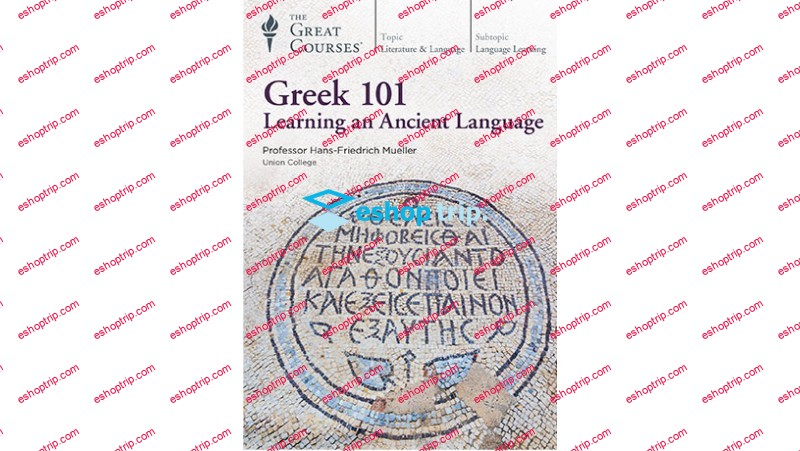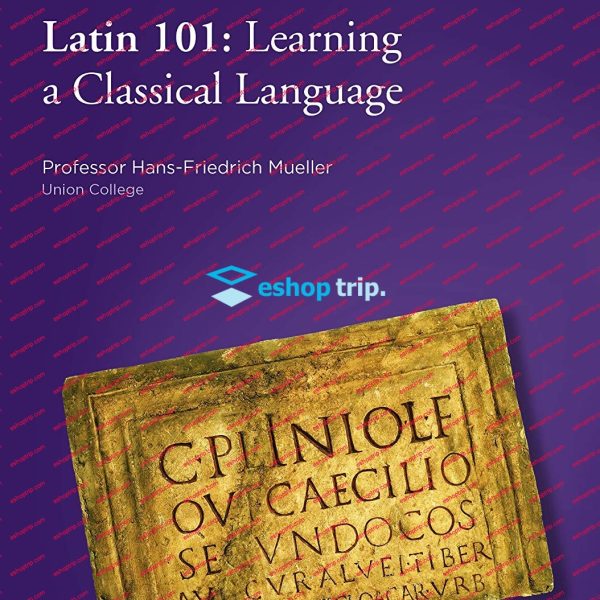TheGreatCoursesPlus – Greek 101: Learning an Ancient Language
17.1 GB
VIDEO + PDF GUIDEBOOK
Learn Ancient Greek from an award winning educator through two of the most important works in the Greek language.
1: The Greek Alphabet & Pronunciation
- Learn the 24 letters of the Greek alphabet using the restored classical pronunciation, recognizing that there was some variation in pronunciation in the ancient world. Practice the pairings of vowels called diphthongs, and sound out a selection of words that you will soon be reading in sentences….
2: First-Declension Nouns
- Discover that Greek nouns have gender and their endings supply a host of information, such as whether the case is nominative, genitive, dative, or accusative-a function usually performed by word order or prepositions in English. Begin with the eight noun endings of the primarily feminine first declension….
3: Basic Rules of Greek Accentuation
- Invented over two thousand years ago by Aristophanes of Byzantium, head of the Library of Alexandria, accents are important clues to the pronunciation of Greek words, and they often provide other crucial information. Learn the rules for the three types of accents: acute, grave, and circumflex….
4: Additional Patterns of the First Declension
- Look at two variations in the pattern of the first declension-one used in Homeric Greek and the other in Koine, the Greek of the New Testament. Despite being separated by almost a thousand years, the two dialects have remarkable continuity….
5: Verbs in the Present Tense
- Greek verbs can be described in terms of person, number, tense, voice, and mood. In this lesson, focus on verbs that are present active indicative. Learn that voice, person, and number are indicated by endings on the verb base. For the present tense, these are called primary endings….
6: Adjective Forms & Second-Declension Nouns
- So far, you have studied first-declension nouns, which are mainly feminine. Now expand your range into masculine and neuter nouns, many of which use second-declension endings. Practice these endings together with their adjectival forms in words that you will encounter in Homer….
7: Building Basic Translation Skills
- Review what you have learned up until now. Then try your hand at translating from English to Greek-first into Homeric Greek and then into Koine, noticing the key differences between the two dialects. Close by reading the opening passage of the Gospel of John in its unadapted original Koine….
8: First- & Second-Declension Pronouns
- Delve deeper into the first and second declensions, discovering that the endings for demonstrative adjectives and pronouns differ in only minor ways from those for nouns. Practice using different types of pronouns, and learn that they underwent a fascinating evolution from Homeric Greek to Koine….
9: Verbs in the Imperfect Tense
- Greek has several ways of talking about the past. Focus on the imperfect tense, which describes an action that was ongoing in the past-for example, “The Achaeans were dishonoring the gods.” The imperfect is built by adding a vowel prefix, called an augment, to the verb base, plus secondary endings….
10: Verbs in the Future & Aorist Tenses
- Learn two new tenses: the future and aorist. In the process, encounter the concept of principal parts, which are indispensable for recognizing different tenses. Concentrate on the first three principal parts for regular verbs (present and imperfect, future, and aorist). Also inspect some irregular verbs….
11: First-Declension Masculine Nouns
- Although first declension nouns are generally feminine, some masculine nouns also fall into this class. Learn how to recognize them (as well as the declensions of all nouns) from the nominative and genitive forms supplied in Greek dictionaries. Then investigate some finer points of compound verbs….
12: The Root Aorist
- The aorist is a past tense that makes no reference to the duration or completion of an action, and focuses instead on the simple act. In Lesson 10, you learned the morphology of the first aorist. Now study the second aorist and root aorist. Analyze examples of all three aorist tenses in the New Testament and Homer….
13: Third-Declension Nouns
- Encounter the third and final declension, focusing, as usual, on the genitive, which is the key to identifying the declension. This is especially important with the third declension, since the noun base is not obvious from the nominative form. Then make your final preparations to read Homer’s Iliad in unadapted Greek….
14: Understanding Dactylic Hexameter
- Read the first five lines of Homer’s Iliad, focusing on vocabulary and grammar. Then investigate the quality that makes Homer a great poet: his use of sound and meter. Homer composed in dactylic hexameter, which was used throughout antiquity. Learn the rules that govern this epic meter….
15: Practicing Dactylic Hexameter
- Practice reciting the first five lines of the Iliad, hearing how the meter enhances the meaning of the text. Then study third declension neuter endings, and read three verses of unadapted New Testament Greek, covering the conversation between the angel Gabriel and Mary in Luke 1:32-34….
16: The Middle/Passive Voice: Present & Future
- Go deeper into Homer with lines 6-10 of the Iliad. Then discover the middle and passive voices. The passive operates as in English, with the subject receiving the action of the verb. However, English doesn’t have a middle voice, which in Greek signals that the subject is acting in its own interest….
17: Aorist & Imperfect Middle/Passive
- In the previous lesson, you learned the primary middle/passive endings, which are used for the present and future tenses. Now compare these to the secondary middle/passive endings, which are used for past tenses. Then read lines 11-16 of the Iliad, learning new rules for scanning dactylic hexameter….
18: Perfect & Pluperfect Active
- Learn the fourth principal part, which governs the formation of the perfect and pluperfect tenses. Discover the great utility of these past tenses for talking about completed action. Study an example of the perfect in John 3:13, and read lines 17-21 of the Iliad….
19: Forming and Using Infinitives
- Study the fifth principal part, which forms the basis of the perfect and pluperfect middle/passive, and the sixth and final principal part, which forms the basis of the aorist passive. Then learn how to construct the infinitive in different tenses, looking at examples in Homer and the New Testament….
20: Active Participles
- Participles are verbal adjectives. Like verbs, they have tense and voice. Like adjectives, they agree in case, number, and gender with the nouns they modify. Learn to form participles in different tenses of the active voice. Study examples in the Gospel of Matthew and in your reading of lines 22-27 of the Iliad….
21: Middle/Passive Participles
- Move on to middle/passive participles. Greek participles pack a lot of meaning into a single word that may require an entire clause to translate into English. Look at examples from two different verses in Matthew as well as your Homeric reading for this lesson: lines 28-32 of the Iliad….
22: The Perfect System in the Middle/Passive
- Learn to form the perfect, pluperfect, and future perfect middle/passive tenses on the basis of the fifth principal part. Study examples in Matthew and Luke. Then read lines 33-37 of the Iliad, which includes a stirring scene “along the shore of the much-roaring sea.”…
23: The Subjunctive Mood
- Turn from the indicative mood to the subjunctive mood, which denotes situations that are doubtful, wishful, purposeful, or fearful. Subjunctives are easily recognized by their long vowel that precedes (or constitutes) the verb ending. Explore several examples, including one from Luke’s Nativity narrative, and read line 38 of the Iliad….
24: The Imperative Mood, Active
- Encounter the imperative mood-the verb construction used for commands. Study the imperative endings in the present and aorist tenses. Find three aorist commands in Luke 22:36, and even more as you continue your reading of the Iliad with lines 39-47….
25: The Imperative Mood, Middle/Passive
- Learn to form imperatives in the middle/passive, looking at examples in Matthew 3:2 and John 14:1. Note that in Homeric Greek the imperative and other verb endings tend to be uncontracted. Then read the Iliad lines 48-52, experiencing the devastation wrought by Apollo’s silver bow….
26: The Optative Mood
- The last of the moods is the optative, which expresses a wish-as in line 42 of the Iliad, where the priest Chryses implores Apollo, “May the Danaans requite my tears….” Find more examples of this easily recognized form in the New Testament. Then continue your reading of the Iliad with lines 53-58….
27: The Aorist Passive
- Delve deeper into the aorist passive, which was introduced in Lesson 19. This tense may sound exotic, but it’s a workhorse in Greek sentences. For example, study the string of aorist passive commands in the Lord’s Prayer in Matthew. Then work your way through lines 59-63 of the Iliad….
28: Third-Declension Adjectives
- In the next four lessons, return to the declension of adjectives and pronouns to explore variations on patterns you have already practiced. In this lesson, focus on third-declension adjectives. Close by reading lines 64-69 of the Iliad. Also learn about a handy class of words called particles….
29: Demonstrative Adjectives & Pronouns
- Investigate the use of Greek demonstrative adjectives and pronouns, which correspond to English words such as this, that, these, and those. Chart a rich sampling of demonstratives, including a reflexive pronoun, in Luke 23:28-29. Then continue with the heightening tension in lines 70-75 of the Iliad….
30: Personal & Possessive Pronouns
- Plumb the depths of Greek personal and possessive pronouns. Begin with the historically later forms of the New Testament, revisiting the Lord’s Prayer in Matthew. Then focus on the pronouns in your next extract from the Iliad, lines 76-80. Along the way, discover a classic figure of speech called chiasmus….
31: Relative, Interrogative & Indefinite Pronouns
- Conclude your exploration of Greek pronouns with interrogative, indefinite, and relative pronouns. These are words such as who, which, and what; and, for indefinite pronouns, someone, something, and similar unspecific descriptors. Look at examples in the New Testament and in the Iliad 81-85….
32: Regular -?? Verbs in the Active
- Bring your study of Greek verbs to a close by focusing on an important class of verbs that end in ?? in the first principal part. There aren’t many such ?? verbs, but they are useful and common, and they appear frequently in compounds….
33: Regular -?? Verbs in the Middle/Passive
- Extend your exploration of ?? verbs, studying the middle passive, which is more regular than the active voice covered in the previous lesson. Note examples of ?? verbs in Luke 22:19, which depicts a moment from the Last Supper, and lines 86-100 of the Iliad….
34: Review of Regular -?? Verbs
- Search for the features that distinguish ?? verbs from the verb forms encountered earlier in the course, whose first principal part ends in ?. Resume your study of the Lord’s Prayer, discovering two ?? verb aorist commands. Then read lines 101-108 of the Iliad, which open with a ?? verb compound….
35: The Verb ????
- The most common ?? verb is also one of the most irregular: to be. Study its forms, discovering that, as unpredictable as it appears, it is more regular than its English counterparts: I am, you are, he is. Then learn to count in Greek, and analyze lines 109-117 of the Iliad….
36: Irregular Verbs & Tips for Further Study
- Learn two more irregular verbs, to go and to know, seeing them at work in sentences from John and Matthew. Then complete your last passage from the Iliad, lines 118-125, and consider strategies for continuing your Greek studies-whether you want to dig deeper into Homer and the New Testament, or discover new masterpieces….











Reviews
There are no reviews yet.